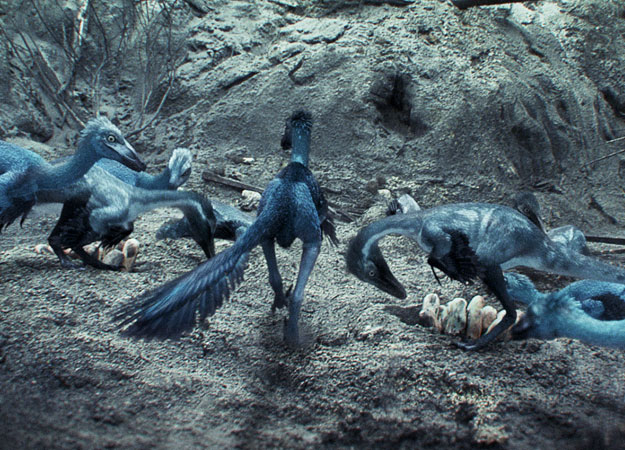 |
| Iridescent feathers in troodontids - possible? Image by Matt Martyniuk, all rights reserved. (Supreme dino fans may recognize the pose even from this small clip...) |
In one of my first posts on feather color mechanisms and their application to extinct groups, I noted that blue coloration is due entirely to structural color, rather than pigmentation, though pigment itself is usually a critical component of that structure. In iridescent feathers, the outer layer of keratin in the barbules (and often segmented and/or containing tiny air pockets) must be a certain thickness to scatter and refract the light in certain ways to create various colors. But, another component is the arrangement of melanin underneath the keratin layer. The thickness and arrangement of melanin layers is as important, if not more important, to the nature of the structural color as the overlying keratin. In fact, it is the distinctive arrangement of melanin alone that can clue researchers in to the presence of iridescence in fossil feathers, such as those of Microraptor zhaoianus (the keratin layer is usually not preserved). Feathers which lack this unique structure are usually matte in coloration, without any glossy sheen or iridescence.
 |
| Iridescent blue troodontids, from Dinosaur Revolution. |
1. Troodonts, being large terrestrial stem-birds, would almost certainly have reduced feather complexity compared to flying or gliding forms, where the expense of maintaining complex feathers is more justified.
I noted that there could be plausible exceptions, such as maintaining complex feathers for display purposes, but I had to admit that this is very unlikely and would be categorized as special pleading. In modern flightless birds, the complexity of feathers is one of the first things to go, first in terms of aerodynamic asymmetry (as in kakapo), and then in terms of degree of pennaceous structure (as in ostriches, kiwi, etc., which have lost their hooklets and reverted to easier to maintain plumulaceous vaned feathers--some details here). Emily noted that Troodon, which were large compared to plesiomorphic troodontids and with highly reduced arms compared to more basal, presumably somewhat more airborne paravians, would be pretty far gone into flightlessness and more akin to ratites, which I agree with. Even depicting them with well-defined, planar sets of vaned feathers, as in Dinosaur Revolution, is probably a mistake.
 |
| Diagram of feathers parts, Fernbank Science Center. |
This is where things get tricky. Are lower-complexity feathers really not capable of supporting structural color? It depends on what you mean by low-complexity. The most important component for creating structural color in feathers are the barbules of feathers, rather than the barbs or hooklets (Monge-Najera & Hernandez, 1994). It stands to reason, then, that feathers without barbules cannot have structural color, and therefore can't be blue. But while the feathers of very derived flightless birds lose their overall structural complexity, this is usually in the form of losing the hooklets and simplifying, rather than losing, the barbules. Indeed, a good example of the murkiness of declaring absolutes here is the case of the cassowary.
 |
| Some derived flightless birds, like cassowary, have glossy feathers similar in structure to iridescent feathers. Photo by Scott Hamlin, licensed. |
 |
| Illustration of cassowary feather. Despite a simple overall structure, it is complex enough to display structurally-created gloss. From this e-book. |
Of course, an additional consideration may be that same issue of behavior. Blue feathers appear to be possible for troodonts, but are they likely based on inferred lifestyle? Troodonts are usually thought to be predators of small vertebrates, possibly nocturnal. Today, nocturnal birds are almost never iridescent, and even diurnal predatory birds tend not to have much in the way of flashy colors. So while iridescent coloration is plausible for troodontids based on biology, it may be less so based on likely behavior.
References
* Maia, R., D'Alba, L., & Shawkey, M. D. (2011). What makes a feather shine? A nanostructural basis for glossy black colours in feathers. Proceedings of the Royal Society B: Biological Sciences, 278(1714), 1973-1980.
* Monge-Nájera, J., & Hernández, F. (1994). Spatial organization of the structural color system in the quetzal, Pharomachrus mocinno (Aves: Trogonidae) and evolutionary implications. Revista de BiologiaTropical, 42, 131-139.

Caudipteryx shows that arm and hand reduction does not mean feather complexity reduction.
ReplyDeleteThis is a good reference for artists who want to improve their rendition of iridescent feathers.
ReplyDeleteThe previous comment was published by me.
ReplyDeleteThis is a good reference for artists who want to improve their rendition of iridescent feathers.
ReplyDelete